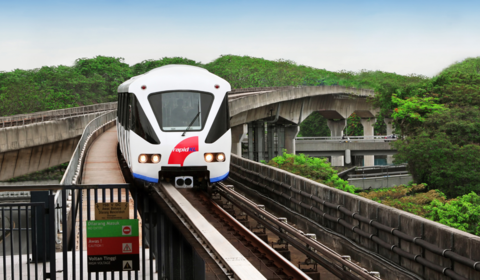
CREATING SAFE, EFFICIENT AND RELIABLE RAILWAYS WITH INDEPENDENT SAFETY ASSESSMENTS (ISA)
As the impact of traffic congestion gets more severe in Southeast Asia, governments in many developing countries have begun developing rail-based public transportation aiming to accommodate mobility demand, especially in large metropolitan cities.
To obtain maximal performance in reducing traffic congestion, the development of modern rail transportation not only needs to adopt the most advanced technology, more importantly, it needs to implement construction processes that sets it apart from conventional railway systems.
The Independent Safety Assessment (ISA) thus has an undeniable role in ensuring the safety and reliability of today's modern rail operations.
Modern Railway – The Solution to Reducing Road Congestion?
Population growth is the most obvious reason traffic congestion has increased in Southeast Asia. With over 600 million people in Southeast Asia, which accounts for about 10% of the world’s total population, the economic cost of congestion is significant with estimates that some countries in Southeast Asia lose approximately two to five percent of gross domestic product due to heavy traffic.
In Indonesia, a study by the Jabodetabek Transportation Management Agency (BPTJ) of the Ministry of Transportation revealed that traffic jams in Indonesia’s most populous area, Jabodetabek, have resulted in economic losses of IDR 71.4 trillion (USD 4.6 billion) per year.
To curb the problem of traffic congestion, effective policies for public transport and increasing the amount of transport infrastructure are necessary for the sustainable growth of major cities in Southeast Asia (KOTI, 2009).
With modern rail transportation in the region being projected to increase five to ten-fold, it is now viewed as a significant solution in accommodating high people mobility while guaranteeing a high level of safety and reliability.
As such, building modern rail transportation has been a key focus of developing countries in Southeast Asia. Malaysia has its East Coast Rail Link for its Peninsula project; Laos has its Laos-China Railway, currently the fastest railway in the region; and the Philippines is currently developing its Metro Manila urban railway system.
Similarly in Indonesia, the government has also intensified the development of their modern rail transportation through their 14 National Strategic Projects such as the construction of the Light Rail Transit (LRT) Jabodebek, Jakarta-Bandung High-Speed Rail, LRT Jakarta Phase 1B Velodrome - Manggarai and LRT South Sumatra.
ISA Ensures High-Level Safety Standards
However, the development of railway systems is complicated and complex. Involving construction, manufacturing of various subsystems and preparation including civil work systems and operation and maintenance readiness, all these form an integrated system with three main objectives: safety, reliability, and efficiency.
The three main types of modern rail transportation are light rail, metro system, and high-speed. Regardless of the rail system, safety is the most important aspect. With modern railways integrating new technologies, failure in a subsystem or integrated system can create life-threatening consequences. Therefore, safety must be ensured in each subsystem, the interfaces between subsystems, and the integrated system.
To allow railway developers in following international standards to achieve safety, the Independent Safety Assessment (ISA) - an internationally recognised framework that allows specifications from a given local context to ensure that all safety requirements are met – was introduced.
Implementing a series of independent judgment activities checked against a set of requirements and references about the safety adequacy of an application and/or device in a defined context and environment, the ISA process is applicable at all project levels and at all phases of the lifecycle.
In general, the ISA involves preparing an assessment plan, collecting and inspecting safety-related documents, audit and inspection and assessment reporting. Results of these activities are reported in official documents such as a List of Open Points (LOP) and Assessment Reports that gives the project owners clarity.
Audit and document assessments of the ISA are performed against criteria such as:
- Quality management
- Safety management
- Functional, non-functional and technical safety requirements, and design specifications
- Specified standards and procedures (e.g., ISO 9001, EN 50126, EN 50128, EN 50129, IEC 61508)
- Best practice and guidance for equivalent systems
- Experience of the Assessors from other system developments with similar characteristics
To optimise the achievement of its goals, the ISA should begin at the start of the project and at every project phase to allow owners and operators to identify, manage and correct critical aspects early and avoid more costly modifications later on.
Seek an Accredited and Recognised Independent Third-Party Body
Performing the ISA for railways require strong expertise in areas related to railway systems and their components to guarantee an exhaustive and coherent safety assessment.
The ISA should be implemented by an accredited and recognised independent body to ensure the integrity of the project.
Other than providing expertise that contributes to improving and guaranteeing an adequate level of safety that reduces time and money, it also provides assurance to the project owner that high standards in accordance with international standards are adhered to.
The development and operation of modern railway is not only a technological advancement in public transportation, it is also a step towards realising sustainable, safe and reliable mobility. For every project owner, the implementation of the ISA is even more necessary amid advances in railway technology which increase complexity and require higher safety standards.
Business Development Manager
Bureau Veritas Indonesia
The implementation of the Independent Safety Assessment is neccessary as advances in railway technology get more complex and require higher safety standards.
